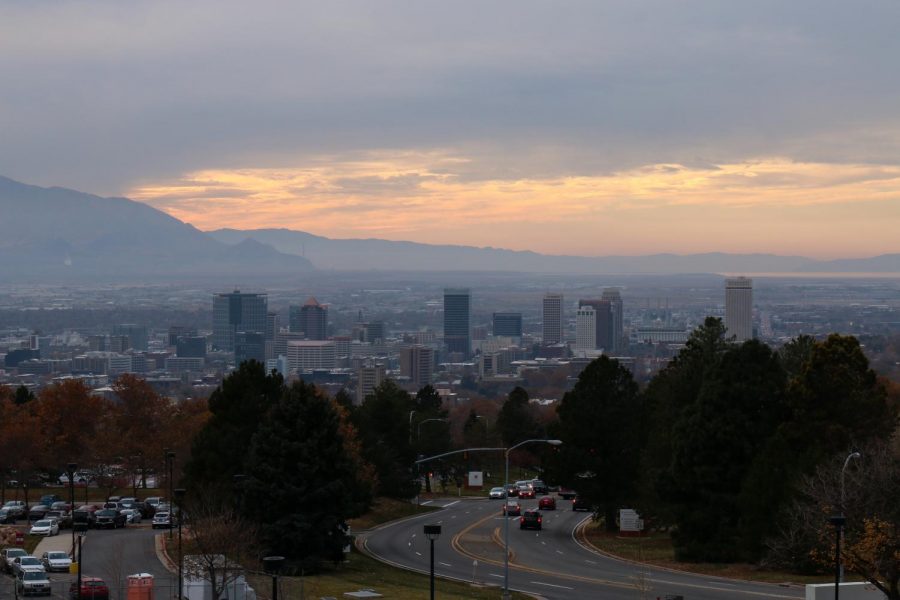Barron: Like Our Air, Staggs’ Plan Need Work
Inversion in Salt Lake City, UT on Friday, Nov. 10, 2017. (Photo by Curtis Lin/ Daily Utah Chronicle)
July 27, 2020
For almost three years, Trent Staggs has served as the mayor of my hometown. Under his leadership, a lot in Riverton has changed, from our logo to our police department. Indeed, 80% of the initiatives outlined in Staggs’ 4-year strategic plan were accomplished in his first two years in office. With apparently little left to do in Riverton, Staggs has set his sights on another mayorship, running as the Republican candidate for Salt Lake County Mayor.
Ever the planner, Staggs’ campaign recently rolled out a plan to improve Salt Lake County’s air quality by promoting teleworking, managing the county’s vehicle fleet, ensuring county-owned buildings are energy efficient, improving public transportation and advocating for smart growth. While his record in Riverton is such that voters can expect Staggs to enact his plan, it is important for residents to note what Stagg’s plan neglects to consider or mention. A truly comprehensive air quality plan for Salt Lake County must address inland port concerns and the impact of COVID-19 fears on initiatives.
Inland Port
In Staggs’ air quality plan, he claims to be pro-growth when it is done “in the right way,” making it clear that the Olympia Hills development, which has recently been reapproved by county officials, is the wrong way for Salt Lake County to grow. Olympia Hills will have a significant impact on air quality, the project is estimated to add almost 80,000 car trips daily by 2042, but so will Utah’s inland port. Similar to Olympia Hills and conspicuously missing from Staggs’ plan, the inland port is widely unpopular among Utahns living near the port site and poses a threat to Salt Lake Valley’s air quality. In fact, the port is projected to be the largest single new source of air pollution Utah has seen in the past 50 years.
Originally, I wrote off Staggs’ choice to focus on Olympia Hills as a desire to stick with familiar issues, the development has been a hot button issue for cities in southwest Salt Lake County like Riverton. However, when asked why the inland port was not included in his air quality plan, Staggs told the Salt Lake Tribune, “I’ve seen some studies … claiming that we are going to see a net drop in carbon emissions based on [the port’s] reliance on rail.”
After two years railing against the development of Olympia Hills, Staggs’ casual optimism about the port’s potential environmental impact is offensive. While the state legislature did recently passed a bill encouraging sustainability at the port, it did not mandate clean-air practices. Deciding whether or not to prioritize Salt Lake’s air quality remains in the hands of the Inland Port Authority Board. As the Salt Lake County Mayor has a seat on this board, Staggs should update his plan to include how he will work to ensure the board protects Salt Lake’s air quality.
Public Transit
Using public transport has long been lauded as one of the easiest ways to improve air quality, the Utah State Legislature even waived UTA fares on bad air days in 2019 to encourage ridership. Unsurprisingly, increasing public transit ridership is a pillar of Staggs’ air quality plan, but strangely he has identified convenience as “the biggest hurdle to increasing ridership in public transportation.” While this may have been true once, safety concerns have taken precedent since the pandemic began, decreasing ridership around the world. Here in Salt Lake, we have seen demand for public transit diminish even though the state has reopened.
While experts agree that high-visibility cleaning coupled with universal mask-wearing is the best way to coax passengers back onto trains and buses, Staggs has publicly called mask mandates “heavy-handed.” But our poor air quality has led Utahns to wear masks to protect their health long before COVID-19. Back in 2016, the U’s Breathe Easy campaign provided discounted reusable filtration masks to protect students from Salt Lake’s toxic air. To ensure his air quality plan is productive, Staggs’ focus must be shifted from adding bus routes to supporting the county’s and UTA‘s mask mandate.
Air quality has always been an issue in Utah, the state struggles to adhere to federal regulations for air quality and Salt Lake’s smog has been linked to serious health issues. But COVID-19 has made cleaning our air is more important than ever, studies have shown exposure to air pollution causes patients to stay on ventilators longer and may increase the likelihood of the virus leading to death. While Staggs’ air quality plan is a good starting point to begin improving Salt Lake County’s air quality, it is currently incomplete. By updating his plan to include how he will advocate for clean air practices at the inland port and support mask mandates, Staggs’ campaign for Salt Lake County Mayor will be bolstered by his comprehensive air quality plan.








